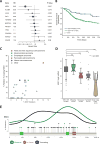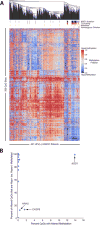Disruption of NSD1 in Head and Neck Cancer Promotes Favorable Chemotherapeutic Responses Linked to Hypomethylation
- PMID: 29636367
- PMCID: PMC6030464
- DOI: 10.1158/1535-7163.MCT-17-0937
Disruption of NSD1 in Head and Neck Cancer Promotes Favorable Chemotherapeutic Responses Linked to Hypomethylation
Abstract
Human papillomavirus (HPV)-negative head and neck squamous cell carcinoma (HNSCC) represents a distinct classification of cancer with worse expected outcomes. Of the 11 genes recurrently mutated in HNSCC, we identify a singular and substantial survival advantage for mutations in the gene encoding Nuclear Set Domain Containing Protein 1 (NSD1), a histone methyltransferase altered in approximately 10% of patients. This effect, a 55% decrease in risk of death in NSD1-mutated versus non-mutated patients, can be validated in an independent cohort. NSD1 alterations are strongly associated with widespread genome hypomethylation in the same tumors, to a degree not observed for any other mutated gene. To address whether NSD1 plays a causal role in these associations, we use CRISPR-Cas9 to disrupt NSD1 in HNSCC cell lines and find that this leads to substantial CpG hypomethylation and sensitivity to cisplatin, a standard chemotherapy in head and neck cancer, with a 40% to 50% decrease in the IC50 value. Such results are reinforced by a survey of 1,001 cancer cell lines, in which loss-of-function NSD1 mutations have an average 23% decrease in cisplatin IC50 value compared with cell lines with wild-type NSD1Significance: This study identifies a favorable subtype of HPV-negative HNSCC linked to NSD1 mutation, hypomethylation, and cisplatin sensitivity. Mol Cancer Ther; 17(7); 1585-94. ©2018 AACR.
©2018 American Association for Cancer Research.
Conflict of interest statement
Trey Ideker is co-founder of Data4Cure, Inc. and has an equity interest. Trey Ideker has an equity interest in Ideaya BioSciences, Inc. The terms of this arrangement have been reviewed and approved by the University of California, San Diego, in accordance with its conflict of interest policies. No potential conflicts of interest were disclosed by the other authors.
Figures




References
-
- Jemal A, Bray F, Center MM, Ferlay J, Ward E, Forman D. Global cancer statistics. CA Cancer J Clin. 2011;61:69–90. - PubMed
-
- Huang SH, Xu W, Waldron J, Siu L, Shen X, Tong L, et al. Refining American Joint Committee on Cancer/Union for International Cancer Control TNM stage and prognostic groups for human papillomavirus-related oropharyngeal carcinomas. J Clin Oncol. 2015;33:836–45. - PubMed
-
- Hitt R, Grau JJ, López-Pousa A, Berrocal A, García-Girón C, Irigoyen A, et al. A randomized phase III trial comparing induction chemotherapy followed by chemoradiotherapy versus chemoradiotherapy alone as treatment of unresectable head and neck cancer. Ann Oncol. 2014;25:216–25. - PubMed
Publication types
MeSH terms
Substances
Grants and funding
LinkOut - more resources
Full Text Sources
Other Literature Sources
Medical
Research Materials

